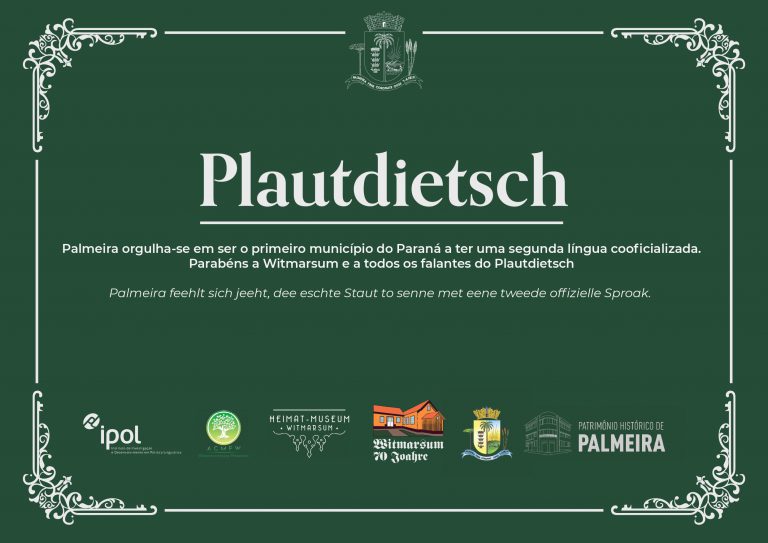Plautdietsch
Conjugate VerbsFacts
- Language: Plautdietsch
- Alternate names: Low German, Mennonite German, Mennoniten Platt
- Language code: pdt
- Language family: Indo-European, Classical Indo-European, Germanic, Northwest Germanic, West Germanic, North Sea Germanic, Altsächsisch, Middle-Modern Low German, Low German, Greater East Low German
- Number of speakers: 400000
- Script: Latin script
More information:
Introduction
Plautdietsch (Mennonite Low German) is a Low Prussian dialect of East Low German with Dutch influence that developed in the 16th and 17th centuries in the Vistula delta area of Royal Prussia. The language is now spoken by about 400,000 people, who are descendants of Mennonites who left Prussia in the 19th century. Already in Prussia, the language that was most often written was German, often called High German, while Plautdietsch was the language of home. German became the language of reading, writing and recordkeeping, while the usual language in the community continued to be Plautdietsch.

Certificate about declaring Plautdietsch an official language in Palmeira municipality, Brazil
In the last century two processes has ignited interest in reading Plautdietsch. On the one hand, people who grew up with Plautdietsch, but have not used it actively in recent years are trying to rebuild on fading roots. On the other hand, thousands of colony Mennonites isolated in Latin American colonies have lost familiarity with High German, and have not acquired their national language. These are finding written Plautdietsch a real eye opener.
There have been a variety of attempts at formalizing written Plautdietsch without much success. The committee which translated the Bible into Plautdietsch (2003) is hoping their orthography, which is followed here and in “Ons Ieeschtet Wieedabuak” will find users and adherents.
The verb
Ablaut series
Plautdietsch forms the past and past participle by changing the root vowel, just like other Germanic languages. The following list is compiled from the different vowel changes.
One ablaut serie consists of 4 vowels separated by a dash:
- The infinitive
- The 3rd person present
- The past
- The past participle
Ablaut series
- a-a-o-o
- trafen
- schrakjen, trakjen
- malkjen
- schwalen
- schwamen
- halpen
- kjwalen
- a-a-ua-a
- wakjen
- a-a-u-o
- omfangen
- a-a-u-u
- emfangen
- a-a-ä-a
- lajen, sajen
- au-au-o-o
- wauschen
- waussen
- au-e-o-o
- faulen
- e-au-u-u
- oppkjennen
- ee-a-a-a
- bleeden
- ee-a-oo-oo
- steeten
- e-e-a-u
- veschwenden
- e-e-au-ä
- setten
- ee-ee-ua-oa
- bieejen, lieejen, flieejen, bedrieejen
- ee-i-a-ee
- seenen
- ee-i-oo-o
- beeden
- scheeten
- jeeten
- steewen
- e-e-o-o
- plekjen
- schenkjen
- henjen, wenjen
- jellen
- jennen
- spennen
- jewennen, schmelten
- e-e-oo-o
- bedden
- e-e-u-u
- schellen
- ei-ei-ee-ä
- dreiwen
- ie-ia-ua-oa
- velieren, frieren
- ie-ie-ee-ä
- kjrieschen
- schienen
- wiesen
- ie-i-ee-ä
- lieden, schnieden, rieden, strieden
- kjniepen, jriepen
- bieten, schmieten, rieten
- bliewen, riewen, driewen, veriewen, schriewen
- ie-ie-ie-ä
- schliepen
- ie-ie-ua-ua
- schwieren
- ie-i-ie-äa
- spieen, schrieen, kjrieen, stieen
- ie-i-oo-o
- schlieten
- i-i-a-äa
- ligjen
- i-i-o-o
- drinkjen, sinkjen, stinkjen
- binjen, dinjen, finjen, rinjen, schrinjen, sprinjen, wrinjen, sinjen, dwinjen, veschwinjen
- äajdwinjen
- kjlinjen
- i-i-oo-o
- flajchten
- i-i-u-u
- äwawinden
- oa-a-ua-oa
- joagen, droagen, froagen
- o-a-ee-o
- schlopen
- loten
- oa-oa-o-o
- oawen, foawen, stoawen
- oa-oa-ua-oa
- moaken, woaken
- foaren
- o-ei-i-o
- gonen
- o-ei-ua-oa
- schlonen
- o-ei-u-o
- stonen
- o-je-je-o
- komen
- oo-ei-ee-o
- doonen
- oo-e-i-oo
- hoolen
- o-o-oo-o
- loden, roden
- foten
- growen
- u-i-oo-o
- krupen, supen
- schluten
- schuwen, schluwen, schnuwen, schruwen
- u-u-ua-oa
- suen
- äa-a-ua-oa
- wäajen
- bräakjen, spräakjen, stäakjen
- ä-a-au-ä
- läsen
- vejäten
- mäten
- ä-a-ee-ä
- äten
- fräten
- ä-e-ee-o
- nämen
- ä-e-ee-ä
- jäwen
- ä-i-ee-ä
- sträwen
- ä-ä-oo-o
- häwen
- ä-ä-o-oo
- befälen, stälen